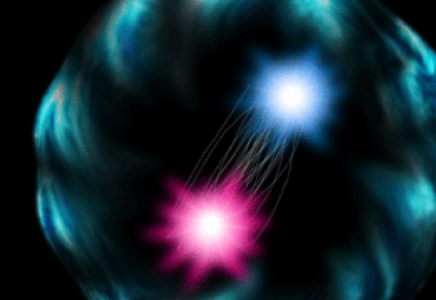Supercomputer Calculations May Allow First Structure Determination of Pion

Pions are the simplest of the particles made of quarks.
Additional Links
Nuclear theorists put pen to paper and code to computer to detail a subatomic particle’s inner structure.
The Science
Pions are the lightest particles to experience nature’s strong force, and one may think they should be simple to understand. Yet, the internal structure of these seemingly simple particles has been difficult to determine. A recent advance in supercomputer calculations using lattice Quantum Chromodynamics (QCD) may allow scientists to, for the first time, provide an accurate and precise description of pion structure.
The Impact
In addition to being the simplest quark-built particles, pions are much lighter than any other particles built of a quark and an antiquark. They were also found by experimental nuclear physicists to be constituents of the atom’s nucleus, mediating the interactions between protons and neutrons. A better understanding of pion structure will lead to a better understanding of many aspects of the subatomic realm.
Summary
While a seemingly simple particle, the structure of the pion is notoriously difficult to extract in physical experiments. To study the pion’s structure, experimenters collide a beam of high energy pions with a proton target to produce pairs of muons and antimuons. The muon pairs are a signature that a quark or antiquark in the pion annihilated with an antiquark or quark in the proton. For a clean theoretical derivation of the pion’s structure, Jefferson Lab theorists have turned to conducting “experiments” on a supercomputer. They performed the experiments by calculating pion scattering cross sections in lattice QCD with a method using supercomputers to describe the interactions of quarks at the subatomic level. They derived the matching formalism, known as factorization, between the pion’s internal structure of quarks and the pion scattering cross sections from physical experiments studying the pion’s structure. Using the lattice QCD data, they were able to extract preliminary data for the distribution of quarks, which describes the pion’s internal structure. The theorists conducted the first proof-of-principle calculations for this method on supercomputers located at the Oak Ridge Leadership Computing Facility and at Jefferson Lab. They found that the results compared well to physical measurements and existing models. The next step is to refine the calculations for a cleaner and more precise extraction of the momentum distribution, or the motion of quarks inside a pion.
Contact
Jianwei Qiu
Jefferson Lab
jqiu@jlab.org
Funding
The U.S. Department of Energy, Office of Science, Office of Nuclear Physics, supports this work within the framework of the TMD Collaboration. The facilities of the USQCD Collaboration (also funded by the Office of Science) were used in part for this research. This research used resources of the Oak Ridge Leadership Computing Facility at the Oak Ridge National Laboratory. The Office of Science Graduate Student Research program, the UK Science & Technology Facilities Council, and the Department of Applied Mathematics and Theoretical Physics at the University of Cambridge also provided support.
Publications
R. Sufian, J. Karpie, C. Egerer, K. Orginos, J. Qiu, and D. Richards, "Pion valence quark distribution from matrix element calculated in lattice QCD," Phys. Rev. D 99, 074507.
https://doi.org/10.1103/PhysRevD.99.074507.
Related Links
Supercomputing on a Shoestring: Cluster Computers at JLab
Computing “Accelerates” Lab Science
April 2019

